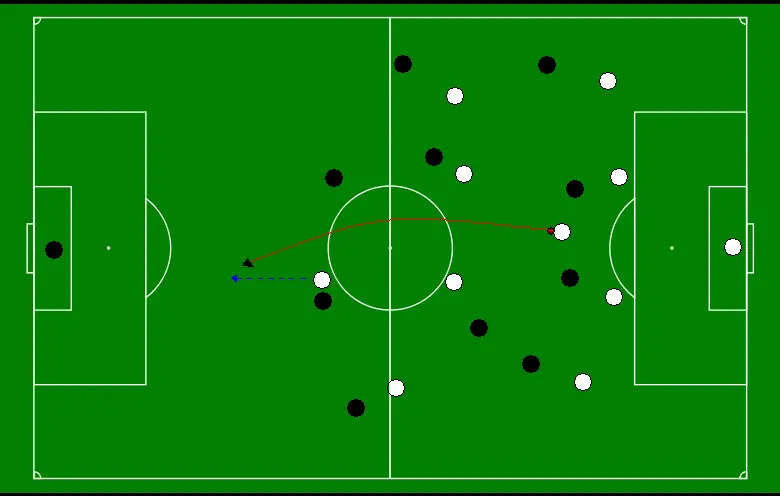
In order to succeed, the defending team must be aware of the opportunity to press together, work assertively to influence passing options, defend vigorously but under control in pressing anyone who receives the ball, and mark accurately those who don't. The goalkeeper for the defenders acts as a sweeper behind the back line.
/cdn.vox-cdn.com/uploads/chorus_image/image/54054435/usa_today_9986252.0.jpg)
All other defenders mark opponents in a position from which they can immediately apply pressure should their opponent receive a pass.Defender 7 moves centrally to discourage and even prevent a pass from attacker 2 to attacker 6.Defender 10 moves to prevent attacker 5 from receiving the ball (in some situations, defenders 9 and 10 could reverse their roles depending on the distance from each other and the likelihood of defender 5 or the goalkeeper becoming the next pass receiver).Defender 9 cuts off the possible pass to the goalkeeper if necessary.Defender 11 presses attacker 2, who is about to receive possession of the ball.In this example, the goalkeeper throws the ball to attacker 2, after which the following sequence immediately occurs. Specifically, the defenders take up positions from which to deter, deny, or intercept passes to their immediate opponents and to press any receiver of a pass from fullback 2.
TACTICAL SOCCER DEFINITION FULL
In contrast, figure 11.3 shows an example of a full-team press where all defenders recognize and contribute to the full pressing tactic high up the field. Therefore, the team tactic of pressing the ball has failed here because of the poor defending of this one player. On receiving the ball under little or no pressure, attacker 9 can turn and attack the back line with a pass or decide to run with the ball centrally to commit opponents. However, central defender 5 fails to mark striker 9, who drops to receive the ball. Immediately upon reading the pass to attacker 3, defender 7 applies pressure with help from defenders 2, 8, and 9. In this example, attacker 6 has passed the ball to attacker 3. Figure 11.2 shows an example of faulty pressing in which four defenders press both the ball holder and possible outlet pass targets. If three players press the opponent urgently and early, but a fourth player does not recognize the situation or contribute to the effort, the tactic is likely to fail, thus allowing the opponent to escape the press. No matter when or where a team adopts a pressing tactic, it must do so through a controlled and high-intensity approach that is adopted by the entire team. Some teams also use an early-pressing tactic for a period of time before dropping deeper toward their own goal to defend. The role of the coach here is to educate players to recognize such possibilities, both in practice and during game play. The cue might be, for example, an uncontrolled pass by the opponent, a square or risky pass to a teammate, a pass to a technically poor or nervous opponent with a defending player nearby, or a certain vulnerable passing circumstance (for example, a pass from a center back to a left back). As a result, some coaches work with their teams to recognize certain triggers or signals that activate the pressing tactic for a relatively short period of time. The continuous high-intensity movement and changes of direction can be fatiguing and erode a player's sharpness, both in and out of possession. Sustaining this pressuring tactic for the duration of a game is demanding in every sense. In either case, the intention is partly to prevent the opposition from gaining momentum to the attack or establishing dominance in possession and partly to test the opponent's will and technical ability to play at high speed. Others use it in a more selective and calculated manner.

Some teams, whose fitness level is high enough, use this pressuring tactic throughout the game. Such an approach is a team tactic that is understood and enforced by all players, and it continues until either the defending team wins possession or the opponent establishes composed possession that compels the defending team to regroup, possibly in a deeper-defending phase of play. As the opposing players try to escape pressure by moving the ball to teammates, other defending players reapply the pressure quickly and relentlessly until possession is regained.


For example, a team equipped with quick defenders who can accelerate rapidly and cover ground (say, 10 yards or meters) at high speed may gear its defensive play to quickly press an opponent who is either receiving or in possession of the ball. Some teams base their strategy on the idea of playing at a speed that they think will disrupt the opponent, either when defending or attacking.


 0 kommentar(er)
0 kommentar(er)
